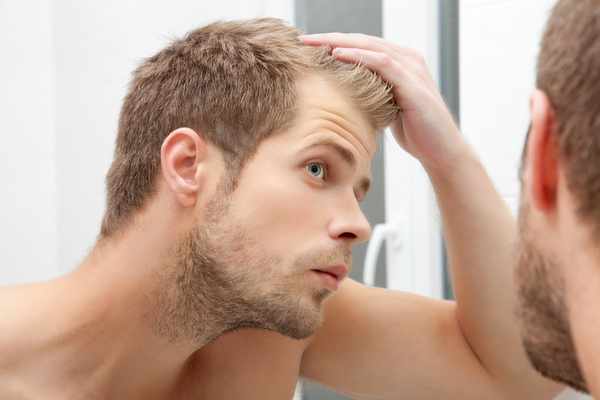Everyone loves a bushy head of hair, but we aren’t always blessed with the hair we want. In some cases, hair loss can even make people feel more self-conscious or unattractive. For those who are looking at their old pictures and longing for their younger hair again, thankfully you do have some new choices. Here are 4 of the best treatment options to help with hair loss!

Understanding Hair Loss
There are a number of reasons someone could start to lose their hair. While a significant majority of hair loss is transferred through genetics, lifestyle plays an important part as well. Even something as trivial as wearing a hat all day could increase your odds of early hair loss, so it is best to consult with a professional to understand your own circumstances.
Worldwide, about 60 percent of men and 50 percent of women experience some form of hair loss. To address this, people often use over-the-counter products, including topical treatments like minoxidil (Rogaine).
Thankfully, there are tons of treatment options to help with hair loss. Let’s take a look at some of them.
What are the Best Hair Loss Treatment Options?
But what if you’re not at the transplant level yet? What if what you want is preventative hair lodd treatment? That’s no problem, as there’s plenty of hair thinning solutions on the market. Here’s some of the best.
1) Men’s Extra Strength 5% Minoxidil Topical Solution for Hair Loss and Hair Regrowth
This product from Rogaine was one of the first FDA-approved hair loss treatments on the market. In order to get your hair back, it stimulates your follicles to grow lush, thick hair once again. According to Dendy Engelman, a prominent dermatologist, its “mechanism of action is believed to be due to an effect on the calcium channels in the hair cells”. It’s lived up to its proud tradition of bringing hair back across the decades.
2) Nutrafol Hair Loss Thinning Supplement
If you want a more natural treatment, this is the supplement for you. This product rebalances your hormones across the hair life cycle to ensure your hair is always healthy and thick. Its unique formula of vitamins, minerals and amino acids will bring lank, thinning hair back to life. Bests results from this hair thinning supplement are seen over several months of consistent use. If you want preventative hair loss treatment, this will provide the nourishment you need.
3) Tea Tree Scalp Care Anti-Thinning Shampoo
This product from Paul Mitchell offers several unique factors in preventative hair care. While the scalp isn’t the most obvious source of your hair thinning woes, it has several biological factors that make it vital in fighting thinning hair. Since the scalp contains sebaceous glands that produce protective oils, the scalp can easily clog hair follicles, leading to far less growing hair. Tea tree oil, turmeric and ginseng are just some of the ingredients in this unique blend that’ll cleanse your scalp, leaving it fresh and ready to produce tons of new hair growth.
What About Hair Transplants?
Hair transplant is another restoration method. The first transplant was performed in 1939 in Japan with single scalp hairs. In the following decades, physicians developed the “plug” technique. This involves transplanting large tufts of hair.
Hair transplants are done to add more hair to an area on your head that may be thinning or balding. It’s done by taking hair from thicker parts of the scalp, or other parts of the body, and grafting it to the thinning or balding section of the scalp.
There are three main types of procedures you can undergo for hair loss treatment.
1) Follicular Unity Strip Surgery (FUSS)
This surgical procedure is one of the most effective hair transplant treatments around. In this, the surgeon removes a strip of skin from an area still growing hair. They then separate the donor skin into tiny follicular units that contain hair follicles. These hair follicles are then inserted into the area you want to gain hair. Local anaesthesia will ensure you don’t feel pain, and the doctor you consult for hair loss will ensure you heal properly.
2) Follicular Unit Extraction (FUE)
In this procedure, the surgeon uses a tiny punch tool to take follicles out from an area still growing hair. This procedure may lead to some scarring. However, it’s less noticeable than the scarring from FUSS, and it won’t need stitches afterward. Be aware that different results occur for different people; one person may get tons of hair, while another may only get a bit.
3) Follicular Unit Transplantation
This procedure is similar to the others, but has some key differences. This hair thinning solution is one of the more traditional on the market. In this, the surgeon extracts a strip of skin that holds hair from the side or the back of the scalp. This is then dissected into individual grafts and put where you want hair.
Conclusion
Of course, when it comes to health, it’s always best to do your own research. Get the best doctor for hair loss treatment near you to consult with you on what would be best to treat thinning hair. But these products and treatments provide a great starting point on getting back the hair you’ve always wanted.
References
[1] Jewell, Tim. “Everything You Need To Know About Hair Transplants.” Healthline. 4 January, 2019.
[2] Berry, Jennifer. “How effective are different hair transplant methods.” Medical News Today. 5 December, 2019.
[3] TNN. “Decoded: Hair Transplant.” Times of India. 6 August 2019.
[4] “Hair Transplants: What to Expect.” WebMD.
